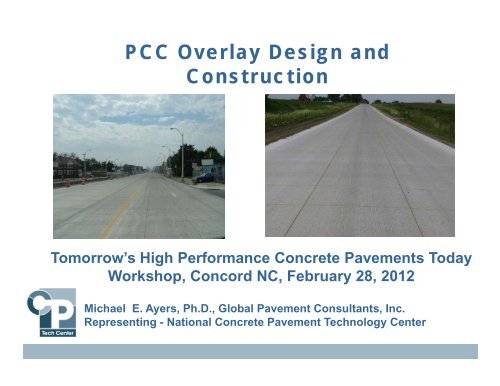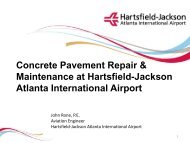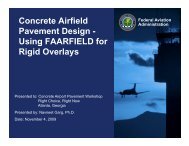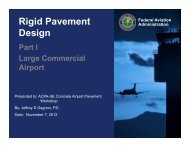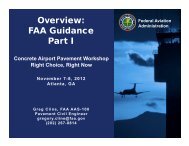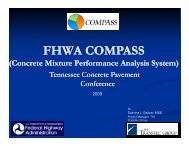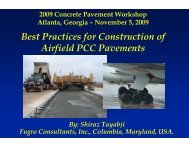PCC Overlay Design and C t ti Construction - American Concrete ...
PCC Overlay Design and C t ti Construction - American Concrete ...
PCC Overlay Design and C t ti Construction - American Concrete ...
Create successful ePaper yourself
Turn your PDF publications into a flip-book with our unique Google optimized e-Paper software.
<strong>PCC</strong> <strong>Overlay</strong> <strong>Design</strong> <strong>and</strong>Construc<strong>ti</strong>on<strong>ti</strong>Tomorrow’s High Performance <strong>Concrete</strong> Pavements TodayWorkshop, Concord NC, February 28, 2012Michael E. Ayers, Ph.D., Global Pavement Consultants, Inc.yRepresen<strong>ti</strong>ng - Na<strong>ti</strong>onal <strong>Concrete</strong> Pavement Technology Center
<strong>Concrete</strong> <strong>Overlay</strong> Guide second edi<strong>ti</strong>onContentst1. Overview of <strong>Overlay</strong>Families2. <strong>Overlay</strong> types <strong>and</strong> uses3. Evalua<strong>ti</strong>ons & Selec<strong>ti</strong>ons4. Six <strong>Overlay</strong> Summaries(11”x17 “sheets)5. <strong>Design</strong> Sec<strong>ti</strong>on6. Miscellaneous <strong>Design</strong>Details7. <strong>Overlay</strong> Materials Sec<strong>ti</strong>on8. Work Zones under Traffic9. Key Points for <strong>Overlay</strong>Construc<strong>ti</strong>on10. Accelerated Construc<strong>ti</strong>on11. Specifica<strong>ti</strong>onConsidera<strong>ti</strong>ons12. Repairs of <strong>Overlay</strong>sSecond Edi<strong>ti</strong>on September 2008
<strong>Design</strong> of <strong>Concrete</strong> <strong>Overlay</strong>s UsingExis<strong>ti</strong>ng Technologies• Lis<strong>ti</strong>ng <strong>and</strong> explana<strong>ti</strong>on of current<strong>and</strong> recommended softwareprograms for specific overlays• Background of recommendedoverlay design techniques• Detailed examples of how to usethe exis<strong>ti</strong>ng design techniques• Learn by example – then apply toyour situa<strong>ti</strong>on!<strong>ti</strong>
Types of <strong>Concrete</strong> <strong>Overlay</strong>sBondedUnbonded2” –5” 4” –11”
<strong>Concrete</strong> <strong>Overlay</strong>sService Life Expecta<strong>ti</strong>ons• Thickness of 2 to 6 in. – 15 to 25 years• Thickness > 6 in. – 20 to 30+ years<strong>Overlay</strong> service life is dependent upon :•Sound overlay structural design - compa<strong>ti</strong>blewith expected traffic <strong>and</strong> site condi<strong>ti</strong>ons, <strong>and</strong>•Good construc<strong>ti</strong>on prac<strong>ti</strong>ces
Bonded <strong>and</strong> Unbonded
Pavement Evalua<strong>ti</strong>on to Determine ifExis<strong>ti</strong>ng Pavement is a C<strong>and</strong>idate for a<strong>Concrete</strong> <strong>Overlay</strong>Poor Choice4” Bonded <strong>Overlay</strong>over 50 yr pavementPoor Choice4” <strong>Concrete</strong> <strong>Overlay</strong> over“D” cracked aggregate
Evalua<strong>ti</strong>ons of Exis<strong>ti</strong>ng Pavementsfor <strong>Overlay</strong>s• Evalua<strong>ti</strong>on is also used to determine:• Required repairs where needed• Establish the concrete overlay designthickness• When combined with an overlay can theexis<strong>ti</strong>ng pavement help carry an<strong>ti</strong>cipatedi t traffic as:- an integrated part of the pavement(bonded)- or serve as a base or subbase
What are WeBuilding the<strong>Overlay</strong>s On?
<strong>Concrete</strong> <strong>Overlay</strong> Quan<strong>ti</strong><strong>ti</strong>es-REALITY CHECK-•<strong>Concrete</strong> is bid in sq.yards for placement,cu. yards for material•Profile is not perfect<strong>and</strong> needs corrected•Cross slope needscorrec<strong>ti</strong>onHoldMinimumThickness<strong>PCC</strong> OVERLAYProfile needscorrectedEXISTING PAVEMENTSlope Varies
Engineering SurveyCost Comparison of Engineering/Surveying Pre Construc<strong>ti</strong>on verses at Time of Construc<strong>ti</strong>onTask Descrip<strong>ti</strong>onBase Cost Es<strong>ti</strong>mated 3 Line Profile <strong>and</strong> 10 Mile Project LegnthTask as Currently PerformedEs<strong>ti</strong>matedHours3 LineProfile Rate TotalAddi<strong>ti</strong>onal Profile CostFive LineProfileNine LineProfileProject scope development 25 $ 95.00 $ 2,375.00$ 2,375.00$ 2,375.00Project control establishment 65 $ 150.00 $ 9,750.00 $ 9,750.00 $ 9,750.00Topo survey 220 $ 150.00 $ 33,000.00 $ 41,250.00 $ 49,500.00Create exis<strong>ti</strong>ng road surface 13 $ 75.00 $ 975.00 $ 975.00 $ 975.00<strong>Design</strong> road profiles 100 $ 88.00 $ 8,800.00 $ 8,800.00 $ 8,800.00Construc<strong>ti</strong>on <strong>ti</strong> survey 190 $ 150.0000$ 28,500.00$ 28,500.00$28,500.00Total $ 83,400.00 $ 91,650.00 $ 99,900.00Cost Per Mile $ 8,340.00 $ 9,165.00 $ 9,990.00*Note: The es<strong>ti</strong>mates show have been generated from six es<strong>ti</strong>mates for construc<strong>ti</strong>on survey that were calculated. Wewere not the successful bidder meaning someone got the work for less money
Quan<strong>ti</strong>ty Es<strong>ti</strong>mates• Es<strong>ti</strong>ma<strong>ti</strong>ng plan quan<strong>ti</strong>ty• <strong>Overlay</strong> cubic yard pay item is to adjust the theore<strong>ti</strong>calvolume by an appropriate factor that accounts for thenon-uniformity of the exis<strong>ti</strong>ng surface<strong>Concrete</strong><strong>Overlay</strong>Thickness½” PlacementTolerance as a %of <strong>Design</strong>ThicknessAddi<strong>ti</strong>onal %Adjustment forGross SurfaceIrregulari<strong>ti</strong>es i in theExis<strong>ti</strong>ng SurfaceTotal AdjustmentFactor to beApplied toTheore<strong>ti</strong>calVolume4” 12.5% 5% 17.5%6” 83% 8.3% 5% 13.3% 3%8” 6.3% 5% 11.3%10” 5.0% 5% 10.0%12” 4.2% 5% 9.2%
Paving with Outside & Inside Stringlines1 st Pass
Paving with Outside Edge Stringline &Ski Combina<strong>ti</strong>on1 st PassUS 287US 69
Paving with Outside Stringline Only &Slope Control1 st Pass
Stringless Paving
<strong>Concrete</strong> Bonded <strong>Overlay</strong> of<strong>Concrete</strong>2” – 5”
Uses <strong>and</strong> Advantages- Bonded<strong>Overlay</strong> of <strong>Concrete</strong>2”–5” thickness• Use when exis<strong>ti</strong>ngpavement is in goodstructural t condi<strong>ti</strong>on withsome surface distress.• Use to eliminate anysurface defects; increasestructural capacity; <strong>and</strong>improve surface fric<strong>ti</strong>on,noise, <strong>and</strong> rideability.• Typically used directly over concrete withoutaddi<strong>ti</strong>onal repairs except for spot-repairing ofseverely deteriorated areas.
Bonded<strong>Concrete</strong><strong>Overlay</strong> over<strong>Concrete</strong>• Where any of the above distress are present, their severity <strong>and</strong> extentshould be considered to determine if a bonded overlay is appropriate.p• Working cracks to be repaired or sawed since they will reflect through.
Coefficient of Thermal Expansion(CTE)• <strong>Overlay</strong> CTE should be similar to underliningpavement• If not near the same at least overlay CTE should belower than exis<strong>ti</strong>ng pavementShearTensile stressOerla <strong>Overlay</strong>ShearExis<strong>ti</strong>ngPavement
Poor Bonding: Delamina<strong>ti</strong>on of<strong>Concrete</strong> <strong>Overlay</strong> over <strong>Concrete</strong>
Maintaining Bond• Replaced Asphalt Patch with <strong>Concrete</strong> Patch
Spot Repairs for Bonded<strong>Overlay</strong>s of <strong>Concrete</strong>JointPatchingFull Depth Patches
Bonded <strong>Overlay</strong> of <strong>Concrete</strong>- FullDepth Cut & Width of Cut
Bonded on <strong>Concrete</strong>Keys to Success• Bond is important• <strong>Concrete</strong> aggregate used in overlay should have thermalproper<strong>ti</strong>es similar to that of exis<strong>ti</strong>ng pavement•Matching gjoints with underlying gpavement allows structure tomove monolithically.• Exis<strong>ti</strong>ng joints must be in fair condi<strong>ti</strong>on or be repaired• Timing of joint sawing is important.• Cut transverse joints full depth +1/2” <strong>and</strong> longitudinal joints atT/2.• Width of transverse joint of overlay to be equal to or greaterthan underlying crack width of the exis<strong>ti</strong>ng pavement.• Curing should be <strong>ti</strong>mely <strong>and</strong> adequate,.
<strong>Concrete</strong> Bonded <strong>Overlay</strong> ofAsphalt or Composite
Bonded <strong>Overlay</strong> of Asphalt orComposite Pavements2”–5” thicknessExis<strong>ti</strong>ng pavement condi<strong>ti</strong>onFair or better structural condi<strong>ti</strong>on withsurface distressApplica<strong>ti</strong>ons•To eliminate surface defects such asrut<strong>ti</strong>ng <strong>and</strong> shoving•Improve surface characteris<strong>ti</strong>cs likefric<strong>ti</strong>on, noise, <strong>and</strong> rideability•To increase structural capacity wheretraffic loads have or will increased
Feasibility• HMA pavements with some structural integrity- Limited structural (fa<strong>ti</strong>gue) cracking- No stripping/raveling in HMA layers- HMA thickness after milling > 3 in to 4 in. minimum• Rut<strong>ti</strong>ng in HMA layers ok• Non-load associated cracking ok
Typical Uses of <strong>Concrete</strong> <strong>Overlay</strong> ofExis<strong>ti</strong>ng Asphalt PavementMichigan Intersec<strong>ti</strong>on•300 trucks per day•160,000 lbs loading
Typical Uses of <strong>Concrete</strong> <strong>Overlay</strong>over AsphaltBefore –Asphalt lasted 3 to 6 monthsAfter- 9 years service of concreteoverlay in wheel lines s<strong>ti</strong>ll performing
Bonded<strong>Concrete</strong>ResurfacingofCompositePavements• Asphalt is a good reflector of underlining concrete pavement condi<strong>ti</strong>on.• A review of the exis<strong>ti</strong>ng profile grade line should be conducted <strong>and</strong> areas ofsignificant ifi devia<strong>ti</strong>on inves<strong>ti</strong>gated t through h analysis of core samples in thelaboratory.CONCRETE RESURFACING OF ASPHALT PAVEMENTS
Purpose of Asphalt Milling for<strong>Concrete</strong> Bonded <strong>Overlay</strong>•Remove distor<strong>ti</strong>ons 2” or more•Reduce high spots to insure minimumoverlay depth•Match adjacent lanes•Help insure good bond•Meet M t ver<strong>ti</strong>cal eleva<strong>ti</strong>on requirements•Restore Profile
Cau<strong>ti</strong>ons on Milling• Milling should beminimized to retain structuralsupport of pavement•Preferable to mill to depththat will minimize thepoten<strong>ti</strong>al for delamina<strong>ti</strong>onbetween lifts•Grade G d correc<strong>ti</strong>ons shouldbe made in the thickness ofthe concrete overlayExcessive milling of exis<strong>ti</strong>ng asphaltbeyond asphalt lifts (tack line)
Over Milling Can Result in StructuralFailure of <strong>Concrete</strong> Bonded <strong>Overlay</strong>over HMA
Joint <strong>Design</strong>• Max.spacingof3to8ftft- Limit 1.0 to 1.5 <strong>ti</strong>mes thicknessin feet.- Some agencies include <strong>ti</strong>e barsat longitudinal joints > 5 in- No dowels (aggregateinterlock relied upon)
Longitudinal Joint Layout2 ft x 2 ft 4 ft x 4 ftOuterShould derOuterShould der3 ft x 3 ft12 ftTraffic6 ft x 6 ft12 ft
<strong>PCC</strong> Joint SawingCRITICAL•Effec<strong>ti</strong>ve curing•Timely joint sawing
Bonded over Asphalt/CompositeKeys to Success•Bonding is cri<strong>ti</strong>cal•Small square panels reduce curling,warping, & shear stresses in bond (1.5<strong>ti</strong>mes thickness).•Mill to remove surface distresses, orimprove bonding.•Be sure to leave 3” to 4” of HMA aftermilling.•HMA surface temperature below 120 Fbefore paving.•Joints in the overlay should not beplaced in wheel paths, if possible•Applica<strong>ti</strong>on of curing compound is cri<strong>ti</strong>cal
<strong>Concrete</strong> Unbonded <strong>Overlay</strong> of<strong>Concrete</strong>
Uses <strong>and</strong> Advantages - Unbonded<strong>Overlay</strong> of <strong>Concrete</strong> Pavements4” - 11” thickness• Use when exis<strong>ti</strong>ng gpavement isin poor condi<strong>ti</strong>on, includingwith material-related distresssuch as D-cracking, whenunderlying pavement <strong>and</strong>subbase are stable <strong>and</strong>uniform except for isolatedareas that can be repaired.• Use to restore structural t capacity of the exis<strong>ti</strong>ngpavement <strong>and</strong> increase pavement life equivalent to fulldepthpavement..
Unbounded <strong>Overlay</strong>sCan be Placed overBadly Distressed<strong>Concrete</strong> Pavements
Unbonded on<strong>Concrete</strong>Exis<strong>ti</strong>ng concrete <strong>and</strong> its subbbase must providea uniform strength platform……if it doesn’t, what ac<strong>ti</strong>ons are necessary to achieve uniformity?
Separator Layer• Required for good performance- Isolate overlay from exis<strong>ti</strong>ng distress• Prevent reflec<strong>ti</strong>on cracking• Prevent bonding/mechanicali interlocking- Provide level surface for overlayconstruc<strong>ti</strong>on• Recommended interlayer material:- 1-2 in HMA- Geotex<strong>ti</strong>le (Missouri Demo – Sept2008)
Need for Adequate Interlayer"KEY"OVERLAYOLD PAVEMENTTHICKERINTERLAYER (1”)SMOOTHER SLIP PLANE
Geotex<strong>ti</strong>le Separa<strong>ti</strong>on Layer(Interlayer)No turnsNo wrinkles
Michigan's Porous HMA Separa<strong>ti</strong>onLayer
Asphalt Stripping
Cross Sec<strong>ti</strong>on or Grade Correc<strong>ti</strong>onswith Interlayer• Tendency to u<strong>ti</strong>lize the asphalt separa<strong>ti</strong>on layer as themedium for correc<strong>ti</strong>ng cross slope & profile• Results in variable asphalt thickness <strong>and</strong> can lead tovery thin asphalt sec<strong>ti</strong>ons (less than 1”)• When compacted creates variable roll down• Varying thickness for fastening dowel bars• Use constant t thickness (typically 1”) as a separa<strong>ti</strong>onlayer• Make cross slope <strong>and</strong> smoothness adjustments in the• Make cross-slope <strong>and</strong> smoothness adjustments in theconcrete overlay
Join<strong>ti</strong>ng-Load Transfer• JPCP joint spacing-1.5 <strong>ti</strong>mes slab thickness in feet < 6 in.-2 <strong>ti</strong>mes slab thickness > 6 in. ( up to 15’)• Transverse joints offset from those in exis<strong>ti</strong>ng• Transverse joints offset from those in exis<strong>ti</strong>ngslab (when possible)
Dowel Bars in Wheel PathFasteners to Exis<strong>ti</strong>ng Pavement Important
Direct <strong>Concrete</strong> Placement in Frontof PaverRemove Unnecessary Dowels
Unbonded <strong>Overlay</strong> of <strong>Concrete</strong> PavementsKeys to Success• Full-depth repairs -only wherestructural integrity is lost at isolatedspots.• Separator layer (normally 1”asphalt or geotex<strong>ti</strong>le fabric)• Use to restore structural capacity of the exis<strong>ti</strong>ng pavement <strong>and</strong>increase pavement life equivalent to full-depth pavement.• Faul<strong>ti</strong>ng of 3/8 in. or less in the exis<strong>ti</strong>ng concrete pavement• Shorter joint spacing helps minimize curling <strong>and</strong> warpingstresses.• To not match joints with those of the underlying concretepavement. p
<strong>Concrete</strong> Unbonded <strong>Overlay</strong> of HMA orComposites- Trouble Shoo<strong>ti</strong>ng
Unbonded <strong>Concrete</strong> <strong>Overlay</strong> of Asphalt orComposite Pavements4” - 11” thicknessExis<strong>ti</strong>ng pavement condi<strong>ti</strong>onDeteriorated (severe rut<strong>ti</strong>ng, potholes,alligator cracking, shoving, <strong>and</strong> pumping)but stable <strong>and</strong> uniformApplica<strong>ti</strong>ons•To restore or enhance pavement’sstructural capacity•To increase pavement life equivalent tofull-depth pavement•To eliminate deteriora<strong>ti</strong>on problems•To reduce urban heat isl<strong>and</strong> effect byincreasing i pavement surface albedo
Semi- Uniform PlatformRemaining i HMA severelydamaged from truckshauling away millingsRemoved 6 in of exis<strong>ti</strong>ng 9-inHMA Pavement
Iowa 175 Longitudinal Crack
Unbonded Over Asphalt/CompositeKeys to Success• Milling to eliminate surface distor<strong>ti</strong>onsof 2 in. or more• Complete repairs at isolated spotswhere structural integrity needsrestoring• <strong>Concrete</strong> patches in the exis<strong>ti</strong>ngpavement should be separated fromthe overlay• Surface temperature of exis<strong>ti</strong>ng asphaltpavement should be maintained below120ºF (48.9ºC) when placing overlay• Par<strong>ti</strong>al bonding between the overlay<strong>and</strong> the exis<strong>ti</strong>ng asphalt pavement isacceptable <strong>and</strong> may even improveload-carrying capacity
SpringCondi<strong>ti</strong>ons<strong>Overlay</strong>Exis<strong>ti</strong>ng pavement (HMA,<strong>PCC</strong>, HMA on <strong>PCC</strong>, etc.)• Cool base; cool nights- Slows set throughout depth of overlay (not just the bottom up)• Base movement is the controlling factor- Cool ground + warming during day = movement- Cooling of base at night (cold above & cold below)Countermeasure: Place concrete overlay during base expansion, notbase contrac<strong>ti</strong>on- Start early; consider covering with plas<strong>ti</strong>c shee<strong>ti</strong>ng- Avoid afternoon & evening pours- Increase <strong>and</strong> monitor concrete placement temperature- Use minimum amount of required SCM’s
FallCondi<strong>ti</strong>ons<strong>Overlay</strong>Exis<strong>ti</strong>ng Pavement(HMA, <strong>PCC</strong>)• Warm base; cool nights- <strong>Concrete</strong> sets from the bottom up• Base movement generally not a problem• May get some r<strong>and</strong>om cracks- Too green on top to allow for saw cut<strong>ti</strong>ng, yet stresses building upfrom bottom of slabCountermeasures:- Place early in day; Use heat of day & sunlight to help surface gainstrength to allow saw cut<strong>ti</strong>ng- Increase <strong>and</strong> monitor concrete placement temperature; warmer isbetter- Cover the slab with plas<strong>ti</strong>c shee<strong>ti</strong>ng
THANK YOU!Michael E. AyersGlobal Pavement Consultants, Inc.Represen<strong>ti</strong>ng the Na<strong>ti</strong>onal <strong>Concrete</strong>Pavement Technology Centermayers@globalpavements.com217-621-3438


